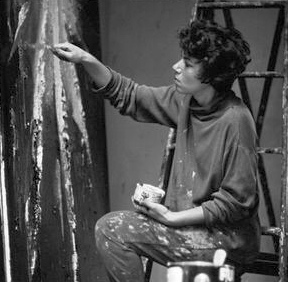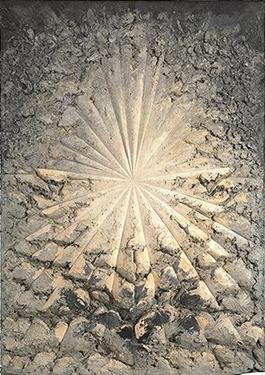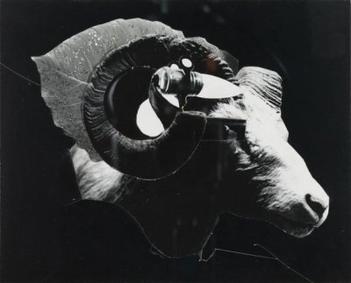Jay DeFeo facts for kids
Quick facts for kids
Jay DeFeo
|
|
|---|---|

DeFeo working on The Jewel
|
|
| Born |
Mary Joan DeFeo
March 31, 1929 |
| Died | November 11, 1989 (aged 60) |
| Nationality | American |
| Known for | Painting |
|
Notable work
|
The Rose |
Jay DeFeo (born March 31, 1929 – died November 11, 1989) was an American artist. She was famous in the 1950s for being part of the exciting group of Beat artists, musicians, and poets in San Francisco. Jay DeFeo is best known for her huge artwork called The Rose. She made many brave and experimental pieces throughout her life. An art critic once said she showed "fearlessness" in her work.
Contents
Jay DeFeo's Early Life and Art Journey
Growing Up and Discovering Art
Jay DeFeo was born Mary Joan DeFeo on March 31, 1929. Her birthplace was Hanover, New Hampshire. Her mother was a nurse from Austria, and her father was an Italian-American medical student.
In 1932, her family moved to the San Francisco Bay Area. Her father became a doctor who traveled for the Civilian Conservation Corps. Jay DeFeo spent time traveling with her parents in Northern California. She also visited her grandparents in Colorado and Oakland, California. When her parents divorced in 1939, Jay moved to San Jose, California with her mother. She went to Alum Rock Union School and was very good at art.
In high school, she got the nickname "Jay," which she used for the rest of her life. Her art teacher, Lena Emery, was an important mentor. Lena Emery took her to museums to see art by famous painters like Pablo Picasso and Henri Matisse. This opened up a new world for the young artist. In 1946, Jay DeFeo started studying at the University of California, Berkeley. She learned from many well-known art professors.
Jay DeFeo liked to experiment with different materials in her art. She used things like plaster and mixed different art supplies. She didn't want to follow strict rules about what materials artists should use.
Starting Her Art Career
In 1953, Jay DeFeo came back to Berkeley. She made large sculptures from plaster, drawings, and small wire jewelry. She met another artist named Wally Hedrick, and they got married in 1954. They lived in San Francisco, near the San Francisco Art Institute. Jay DeFeo worked as an artist's model to earn money.
She also made jewelry to support herself. She created small paintings and drawings too. Jay DeFeo had her first solo art show at The Place. This was a tavern in San Francisco where poets often gathered. She also showed her jewelry at Dover Galleries in Berkeley. Over the next few years, her art was part of many group exhibitions.
In 1955, Jay DeFeo was featured in a group art show called "Action." The paintings in this show were placed around a working merry-go-round. Later that year, Jay DeFeo and Wally Hedrick moved to a bigger apartment. This allowed DeFeo to create larger artworks. Their apartment became a popular spot for other artists, writers, and jazz musicians.
Jay DeFeo was also involved with The 6 Gallery. This gallery was started by Wally Hedrick and other artists. She was there when the famous poet Allen Ginsberg first read his poem Howl in 1955. In 1959, Jay DeFeo became a founding member of Bruce Conner’s Rat Bastard Protective Association.
In 1959, her work was chosen for a very important exhibition. It was called Sixteen Americans and was held at the Museum of Modern Art in New York. Her art was shown alongside famous artists like Jasper Johns and Robert Rauschenberg. After this, she had a solo show at the Ferus Gallery in Los Angeles.
The Rose: A Masterpiece of Art

Jay DeFeo's most famous painting is The Rose. She worked on this painting for almost eight years, from 1958 to 1966. This amazing artwork is over ten and a half feet tall. It weighs more than one ton!
As she worked, Jay DeFeo added many layers of paint. Then she carved parts of it away, almost like a sculptor. In the end, the painting looked like a starburst. It had thick ridges of white paint that spread out. These ridges led to a rougher gray area that sparkled with mica.
Jay DeFeo mostly finished The Rose when she had to leave her apartment in November 1965. Her friend Bruce Conner said she needed something big to happen to make her finish it. He even made a short film called The White Rose (1967) about the painting's removal. The film shows how huge the painting was. They had to knock out part of a wall to get it out! A forklift carried the painting away.
The Rose was taken to the Pasadena Art Museum. Jay DeFeo added the final touches in 1966. After that, she took a four-year break from making art. In 1969, the painting was finally shown in solo exhibitions. These were at the Pasadena Art Museum and the San Francisco Museum of Modern Art. Later, the painting was stored at the San Francisco Art Institute. It stayed hidden behind a wall until 1995. The Whitney Museum of American Art then restored and bought the artwork for its collection.
Jay DeFeo's Artistic Style and Later Years
Exploring Different Art Forms
Jay DeFeo made art for forty years. She used many different materials and methods. She created drawings, paintings, sculptures, jewelry, and photographs. She also made photocopies, collages, and photo collages. She always tried new things with each art form.
Jay DeFeo developed her own "visual vocabulary." She played with the size of her art. She explored using color versus black and white. She also experimented with textures and making things look textured. She once wrote that she always remembered her past work while creating new pieces. Jay DeFeo often made her art in series. She would explore light and dark versions, or mirror images. Sometimes, her art started from a small everyday object. Things like a dental bridge or swimming goggles could inspire her. She would turn these ordinary items into something with a "universal character."
Photography and Travel Inspirations
In the 1970s, Jay DeFeo became very interested in photography. In 1970, a friend loaned her a camera. She learned how to develop film and make prints with help from her students. In 1973, she won a grant. With this money, she bought a camera and built a darkroom at home. She continued to explore photography and photo collages for several years.

One example is her photo collage called Untitled from 1973. In this piece, she combined images of everyday objects in surprising ways. In the late 1970s, her photography focused more on her art in the studio. This became like a "visual diary" made of hundreds of contact sheets.
In the 1980s, Jay DeFeo went back to using oil paint. She had used acrylic paint for ten years before that. In 1984, she traveled to Japan with a friend. This trip, along with an exhibit of Japanese helmets, inspired her Samurai drawing series in 1987. In 1987, she traveled to Africa. This trip inspired her to create a series of abstract drawings called Reflections of Africa. She even used a tissue box as a starting point for these drawings. In Africa, Jay DeFeo climbed to the top of Mount Kenya. This mountain is over 17,000 feet high. It was a dream come true for her to climb a major mountain.
For many years, Jay DeFeo taught art part-time. She taught at places like the San Francisco Art Institute and the San Francisco Museum of Modern Art. In 1980, she got her first full-time job at Mills College. She eventually became a special art professor there.
Personal Life and Legacy
After leaving her Fillmore Street apartment, Jay DeFeo and Wally Hedrick separated. They divorced in 1969. In 1967, she started a relationship with John Bogdanoff. They lived in Larkspur, California. After they separated, she moved to Oakland in 1981. She built a large studio where she could live and work. She kept creating paintings, drawings, photocopies, and collages.
Jay DeFeo had many good friends, inspiring students, and friendly dogs. She was diagnosed with lung cancer in 1988. Even then, she continued to create a lot of art. She passed away on November 11, 1989, at the age of 60.
Exhibitions and Art Collections
The Whitney Museum of American Art has the largest public collection of Jay DeFeo's work. They held a big exhibition of her art from February to June 2013. This show also traveled to the San Francisco Museum of Modern Art. Since then, her art has been shown in many solo exhibitions. These include shows at Gagosian in San Francisco and Mitchell-Innes & Nash in New York.
Jay DeFeo's work has also been part of many group exhibitions. These include shows at the Museum of Modern Art in New York and the Tate Modern in London. Her art is also in the collections of many other important museums. These include the Art Institute of Chicago, the British Museum, and the J. Paul Getty Museum.
Legacy
The Jay DeFeo Foundation was created after her death. This foundation helps to encourage the arts. It also works to keep her artworks safe and show them to more people.
See also
 In Spanish: Jay DeFeo para niños
In Spanish: Jay DeFeo para niños

